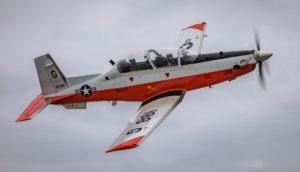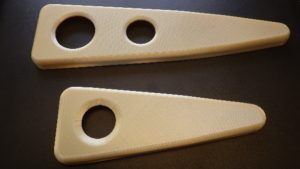 Recent delivery of 15 T-6B Texan II dorsal assembly ribs in a matter of weeks is an example of how quickly stakeholders can increase readiness through collaboration and innovation.
Recent delivery of 15 T-6B Texan II dorsal assembly ribs in a matter of weeks is an example of how quickly stakeholders can increase readiness through collaboration and innovation.
“With additive manufacturing (AM), the fleet can now get the parts in a matter of hours in addition to having an additional source of production,” said Chief of Naval Air Training (CNATRA) Assistant Chief of Staff for Aircraft Readiness Capt. Thomas Gibbons. “Establishing this capability locally could also potentially save us effort and cost.”
CNATRA decided to replace the aircraft’s ribs after a series of regularly scheduled inspections of the T-6B. “We believed our workforce had the skills to replace the ribs at the wing, instead of taking aircraft out of service to send them to a maintenance facility,” Gibbons said.

The dorsal assembly extends from the aircraft’s rear fin towards its nose. It helps provide directional stability during asymmetrical flight cause by external conditions such as crosswinds. An internal support structure, the dorsal assembly’s forward rib measures approximately 3 inches wide by 8 inches tall and the aft rib is approximately 3.5 inches wide by 12 inches tall.
An initial request was sent to the Naval Undergraduate Flight Training System Program Office (PMA-273)—the program office for T-6Bs—focusing on adding instructions to the aircraft’s structural repair manual. CNATRA learned from the program office that it could not begin work immediately even if they were granted authority to conduct the repair; industry had to manufacture the ribs first.
“I quickly realized AM could be used to produce the dorsal assembly ribs,” Gibbons said. “The brief described the amazing products that were produced using AM,” he said. “I thought it was perfect to meet our need and even began to consider how it could be used for other requirements.”
Myers was also familiar with McMichael’s brief and engaged another stakeholder, the T-6B’s Fleet Support Team (FST), to begin the process.
McMichael is one of many experts integrating AM into Naval Aviation’s day-to-day activities. Her team is part of AIRWorks, a collection of teams within NAVAIR’s Warfare and Fleet Readiness Centers with capabilities to engineer, prototype, build, install and test one-time or low-volume production solutions.
She said Gibbons inquiry underscores the need to reach out to as many stakeholders as possible and let them know how AM can be used. “There are 48 items pre-approved for printing so far. This means they don’t have to ask for an engineering disposition. Sailors and Marines can print what they need when they need it and use it for the purpose it was designed for,” she said.
Items not on the list, however, need to demonstrate their airworthiness before being approved for production and installation. They must undergo AM development which involves maturing the technology and setting standards for printing. This was the case for the dorsal assembly ribs.
Approximately 60 days after the initial inquiry, AM printing of the dorsal assembly ribs was approved. Fifteen were printed and installed on T-6Bs at Naval Air Station (NAS) Whiting Field, Florida, and NAS Corpus Christi, Texas. August 1 marked their first flights.
The entire process from request to installation took two months despite CNATRA, the program office and the OEM having limited experience with AM. “The manufacture [of the dorsal assembly ribs] was reduced to a matter of hours and 10 percent of its original cost,” Myers said. “Now that it has been approved for use, requests for six more ribs have been submitted.”
McMichael said manufacturing the ribs exemplifies what is possible with AM and cross-functional teams. “The fleet and the program office saw AM as a possible solution and reached out to us,” she said. “CNATRA, PMA-273, Engineering, FST and the original equipment manufacturer DynCorp International all worked together to increase speed to the fleet and provide an additional source for dorsal assembly ribs.”


